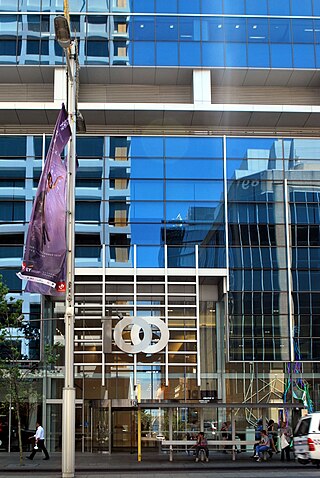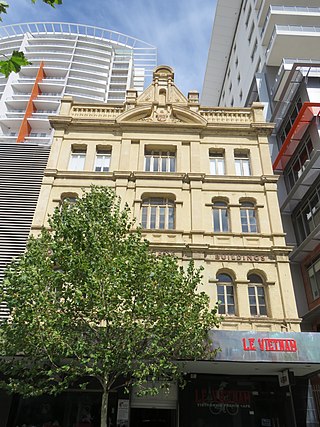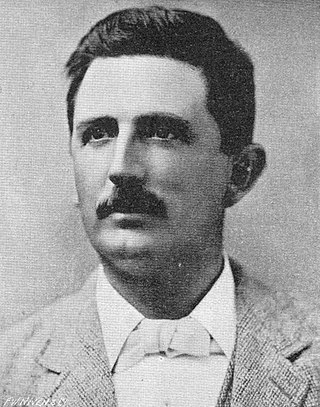
York is the oldest inland town in Western Australia, situated on the Avon River, 97 kilometres (60 mi) east of Perth in the Wheatbelt, on Ballardong Nyoongar land, and is the seat of the Shire of York.

The Causeway is an arterial traffic crossing in Perth, Western Australia, linking the inner-city suburbs of East Perth and Victoria Park. It is carried over the Swan River at the eastern end of Perth Water by two bridges on either side of Heirisson Island. The current Causeway is the third structure to have been built across the river at this point.

Barrack Street is one of two major cross-streets in the central business district of Perth, Western Australia. Together with St Georges Terrace, Wellington Street and William Street it defines the boundary of the main shopping precinct of the central city.

Hay Street is a major road through the central business district of Perth, Western Australia and adjacent suburbs. The street was named after Robert William Hay, the Permanent Under Secretary for Colonies. Sections of the road were called Howick Street and Twiss Street until 1897. One block in the central business section is now a pedestrian mall with extremely limited vehicular traffic, so that it is necessary to make a significant detour in order to drive the entire length of Hay Street.
Australian non-residential architectural styles are a set of Australian architectural styles that apply to buildings used for purposes other than residence and have been around only since the first colonial government buildings of early European settlement of Australia in 1788.

London Court is a three and four-level open-roofed shopping arcade located in the central business district in Perth, Western Australia. It was built in 1937 by wealthy gold financier and businessman Claude de Bernales for residential and commercial purposes. The arcade runs between the Hay Street Mall and St Georges Terrace and is considered an important tourist attraction in the City of Perth. It received a National Trust of Australia classification in 1978 and was recorded in the Register of the National Estate in 1982. The Heritage Council of Western Australia included it in the State Heritage Register in 1996.

Wesley Church is a Uniting Church in Perth, Western Australia, located at the corner of William Street and Hay Street. It is one of the oldest church buildings and one of few remaining 19th-century colonial buildings in the City of Perth.

100 St Georges Terrace is a 24-storey skyscraper located at 100 St Georges Terrace in Perth, Western Australia.

Henry Trigg (1791–1882) was the Superintendent of Public Works in Western Australia from 1839 to 1851 and founder of the Congregational Church in Perth.

The Gledden Building is an Art Deco office building in Perth, Western Australia. The building was constructed on land that had been bequested to the University of Western Australia by surveyor Robert Gledden.

St Andrew's Uniting Church is a heritage-listed Uniting church at 131 Creek Street, Brisbane CBD, City of Brisbane, Queensland, Australia. It was designed by George David Payne and built in 1905 by Alexander Lind & Son. Initially St Andrew's Presbyterian Church, it became part of the Uniting Church following the merger of the Presbyterian, Methodist and Congregational Churches in 1977. It was added to the Queensland Heritage Register on 21 October 1992.

The Old Fremantle Police Station and Court House Complex is a heritage-listed group of buildings located at 45 Henderson Street, Fremantle, Western Australia. The complex includes the former courthouse, police station, police barracks and lock-up and artillery drill hall.

Stirling Terrace is the main street of Toodyay, Western Australia, originally called New Road until 1905.

Scots Church is a stone Uniting Church building on the southwest corner of North Terrace and Pulteney Street in Adelaide, the capital city of South Australia. It was one of the early churches built in the new city in 1850. It was built as the "Chalmers Free Church of Scotland".

The Ross Memorial Church is a Uniting church on Hay Street in West Perth, Western Australia, Australia. Established as a Presbyterian church in 1917, the church is home of the Wesley worshipping community of the Uniting Church in the City.

Holy Trinity Church is a heritage-listed Anglican church on the corner of Newcastle and Pool Streets, in York, Western Australia. The church was consecrated in 1858 by the first Anglican Bishop of Perth, Mathew Blagden Hale.

The Trinity Uniting Church is a heritage-listed Uniting church located at 62 The Boulevarde, in the Sydney suburb of Strathfield in the Municipality of Burwood local government area of New South Wales, Australia. It was designed by George Sydney Jones & Harry Thompson and built from 1889 to 1890 by Thomas Hanley of Balmain. It is also known as Trinity Congregational Church. The property is owned by the Uniting Church in Australia. It was added to the New South Wales State Heritage Register on 19 September 2003.

Bon Marché Arcade, also known as Bon Marché Buildings, is a heritage-listed building in Perth, Western Australia], located at 74–84 Barrack Street in the Perth central business district. It is three and four storeys tall, built in 1901 from brick in the Federation Free Classical architectural style, with a tin roof. Designed by architect H. J. Prockter, it was a prominent feature in Barrack Street when constructed, being taller than the one or two story buildings surrounding it.

Henry Stirling Trigg, also known as Harry, was a prominent Western Australian architect. He was the grandson of Henry Trigg, and the first architect both born and trained in Western Australia.





















